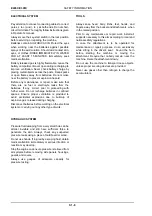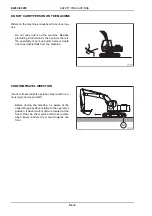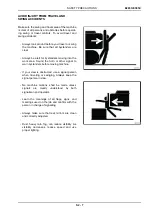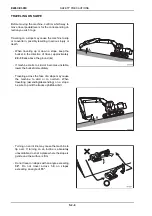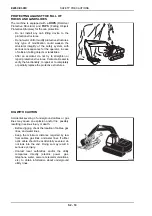
S1 - 5
SAFETY INFORMATION
E265C-E305C
horn. Make sure that nobody is within the machine
operating range. Lower the attachment slowly.
Securely block and lock the machine every time you
leave it unattended. Return keys to the safe place
previously agreed upon. Perform all necessary
operations for stopping as detailed in the Operator's
manual.
Drive the machine far from pits, trenches, rocky
hanging walls, areas with overhead electric lines, and
slopes before stopping it at the end of the working
day.
Move all controls to the position specified for machine
stopping.
Never park on an incline without accurately blocking
the machine to prevent unexpected movement.
Follow stopping instructions contained in the
Operator's manual.
MAINTENANCE
Carefully read the Operator's manual before starting,
operating, maintaining, fuelling or servicing the
machine in any manner.
Read all safety decals mounted on the machine and
observe instructions they contain before starting,
operating, repairing, fuelling or servicing the
machine.
Do not allow unauthorised personnel to repair or
service the machine.
Follow all recommended maintenance and service
procedures.
Do not wear rings, wrist watches, jewellery, loose or
hanging garments, such as ties, torn clothing,
scarves, unbuttoned or unzipped jackets that can get
caught in moving parts. Wear certified safety clothes
such as: hard hat, no-slip footwear, heavy gloves, ear
protection, safety glasses, reflector vests, respirators
when required. Ask your employer about safety
regulations in force and protective equipment.
Do not use controls or hoses as hand holds. Hoses
and controls are movable parts and do not provide
solid support. Besides, controls may be inadvertently
moved and cause unexpected movement of the
machine or its attachments.
Do not jump on or off the machine. Always keep both
hands and one foot, or both feet and one hand in
contact with steps and/or grab rails.
Never service the machine with someone sitting in
the driver’s seat, unless this person is an authorised
operator assisting in the maintenance being carried
out.
Keep the operator’s compartment, step plates, grab
rails and handles clear of foreign objects, oil, grease,
mud orsnow to minimise the danger of slipping or
stumbling.
Clean mud or grease from your shoes before
climbing on the machine or driving it.
Never attempt to operate the machine or its
attachments from any position other than sitting in the
operator’s seat.
Keep the driver’s seat free from foreign objects,
especially if these are not secured.
Should it be necessary to move the attachment for
maintenance purposes, do not raise or lower the
attachment from any other position than sitting in the
operator’s seat. Before starting the machine or
moving its attachment, sound the horn and require
that nobody remains near the machine.
Raise the attachment slowly.
Always lock all moving components or parts of the
machine that must be lifted for maintenance
purposes using adequate external means as
required by local and national regulations. Do not
allow anyone to pass or stay near or below a raised
attachment. If you are not absolutely sure about your
safety, do not stay or walk under a raised attachment.
Do not place head, body, limbs, hands, feet or fingers
near articulated cutting edges deprived of the
necessary guards, unless they are suitably and
safely locked.
Never lubricate, repair or adjust the machine with the
engine running, except when this is specifically
required by the Operator's manual.
Do not wear loose clothing, jewellery near rotating
parts.
When service or maintenance require access to
areas that cannot be reached from the ground, use a
ladder or step platform conforming to local or national
regulations to reach the working area. If such means
are not available, use machine grab rails and steps.
Always perform all service or maintenance work with
the greatest care and attention.
Shop and/or field service platforms or ladders should
be manufactured and maintained in accordance with
local or national safety regulations in force.
Disconnect batteries and label all controls to warn
that service work is in progress, according to local
and national safety regulation requirements.
Block the machine and all attachments to be raised
according to local and national safety regulation
requirements.
Do not check or fill fuel tanks or install batteries near
burning or smoking materials and open flames due to
the presence of flammable vapours.
The fuel filler pipe nozzle must be constantly kept in
contact with the filler neck and this even before fuel
starts flowing in. Keep this contact from the beginning


















